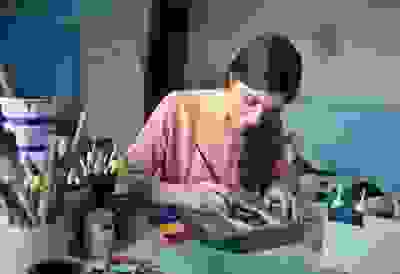SCIENTIFIC LITERATURE
Publications Authored by Elisa Rega
Elisa Rega is a psychology researcher who is currently working at the Oregon Institute of Occupational Health Sciences at OHSU in the Safety Climate Lab under Dr. Emily Huang. Previously, Ms. Rega researched creativity enhancement at the National Chengchi University in Taiwan under Dr. Terri Yu-Chu Yeh.
Educational Psychology Research
Aesthetics-Integrated teaching
Yu-chu Yehab, Elisa Marie Rega, Szu-Yu Chena
https://doi.org/10.1016/j.compedu.2019.05.007
HIGHLIGHTS
• A FACE (Feedback, Aesthetics, Creative design, and Evaluation) model was proposed.
• A computer-based interdisciplinary paradigm of creativity training was conducted.
• Training that related to real-world experience enhanced aesthetics and creativity.
• Constructive feedback led to better learning effects than informational feedback.
• Emotional creativity and desire for aesthetics moderated the training effects.
ABSTRACT
The majority of creativity enrichment research has focused on creative skills pertaining to originality which is assessed by divergent thinking tests. This study aimed to explore a new-paradigm for creativity enhancement—improving creativity through the FACE (Feedback, Aesthetic experience, Creative design, and Evaluation of designed products) computer-based training program in which aesthetic experience and 3-D creative design were incorporated. Moreover, possible moderators such as emotional creativity (EC) and desire for aesthetics (DA) were investigated during the training. In concurrence with these endeavors, 76 college students participated in a control-group experimental design study investigating the effectiveness of the FACE training; it was invented to promote cognitive aesthetic enhancement and improve creative performance on a 3-D coffee shop design. In addition, inventories regarding emotional creativity (EC) and desire for aesthetics (DA) were employed. The findings suggest that the employed training program enhanced college students’ aesthetic understanding, and further improved their creativity through both conscious and unconscious processes. Notably, training that included constructive feedback led to better learning effects than the condition that included informational feedback. Furthermore, emotional creativity (EC) and desire for aesthetics (DA) played moderating roles during the learning process of creativity. This study provides a new archetype for improving creativity and the results support the possibility and importance of integrating aesthetics and creativity enhancement in computer based learning systems for modern educational methods.

Educational Psychology Research
Minful Learning
Front. Psychol., 17 July 2019 | https://doi.org/10.3389/fpsyg.2019.01593
Yu-chu Yeh1,2*, Szu-Yu Chen1, Elisa Marie Rega1 and Chin-Shan Lin1
- 1College of Education, National Chengchi University, Taipei, Taiwan
- 2Research Center for Mind, Brain and Learning, National Chengchi University, Taipei, Taiwan
ABSTRACT
This study was performed within the limited framework of computer-game-based educational programs designed to enhance creativity. Furthermore, the utilization of mindful learning and moderators such as flow, mastery experience, and self-efficacy, brings this research to the forefront of modern educational practices. The present researchers developed a comprehensive game-based creativity learning program for fifth and sixth grade pupils. Further analyses presented relationship trends between mindful learning experience, flow experience, self-efficacy, and mastery experience. Eighty-three 5th and 6th grade participants undertook the six-week game-based creativity learning program. Upon completion of the experimental instruction, self-evaluation revealed that participants with higher scores on the concerned variables improved more in both creative ability and confidence than their counterparts. Additionally, path model analysis revealed that mindful learning experience was a powerful predictor of both mastery experience and flow experience; it also influenced mastery experience through flow experience and self-efficacy. The findings support the effectiveness of the game-based learning program developed in this study. Moreover, this study contributes to the theoretical construction of how game-based learning can be designed to facilitate mindful learning experience, flow experience, self-efficacy, and mastery experience during creativity. Some additional enhancement mechanisms utilized in the program were: rewards for high-quality performance, challenging tasks, a variety of design components, immediate feedback, and idea sharing. The theoretical design of this study provides support for the ongoing scientific investigation of new applications of mindful learning in educational programs concerning the learning of creativity.
fMRI Neuroscience Research
Brain Networks During Creative Tasks
The Dynamic Relationship of Brain Networks Across Time Windows During Product-Based Creative Thinking
DOI:10.17265/2159-5542/2019.10.002
Author(s)
Yu-chu Yeh
Wei-Chin Hsu
Elisa Marie Rega
Affiliation(s)
National Chengchi University, Taipei, Taiwan
National Taiwan University of Science and Technology, Taipei, Taiwan
Oregon Health & Science University, Portland, Oregon, United States
ABSTRACT
Consensus of creativity research suggests that the measurement of both originality and valuableness is necessary when designing creativity tasks. However, few studies have emphasized valuableness when exploring underlying neural substrates of creative thinking. The present study employs product-based creativity tasks that measure both originality and valuableness in an exploration of the dynamic relationship between the default mode (DMN), executive control (ECN), and salience (SN) networks through time windows. This methodology highlights relevance, or valuableness, in creativity evaluation as opposed to divergent thinking tasks solely measuring originality. The researchers identified seven brain regions belonging to the ECN, DMN, and SN as regions of interest (ROIs), as well as four representative seeds to analyze functional connectivity in 25 college student participants. Results showed that all of the identified ROIs were involved during the creative task. The insula, precuneus, and ventrolateral prefrontal cortex (vlPFC) remained active across all stages of product-based creative thinking. Moreover, the connectivity analyses revealed varied interaction patterns of DMN, ECN, and SN at different thinking stages. The integrated findings of the whole brain, ROI, and connectivity analyses suggest a trend that the DMN and SN (which relate to bottom-up thinking) attenuate as time proceeds, whereas the vlPFC (which relates to top-down thinking) gets stronger at later stages; these findings reflect the nature of our creativity tasks and decision-making of valuableness in later stages. Based on brain region activation throughout execution of the task, we propose that product-based creative process may include three stages: exploration and association, incubation and insight, and finally, evaluation and decision making. This model provides a thinking frame for further research and classroom instruction.
KEYWORDS
default mode network, dynamic connectivity, executive control network, product-based creativity, salience network, time window